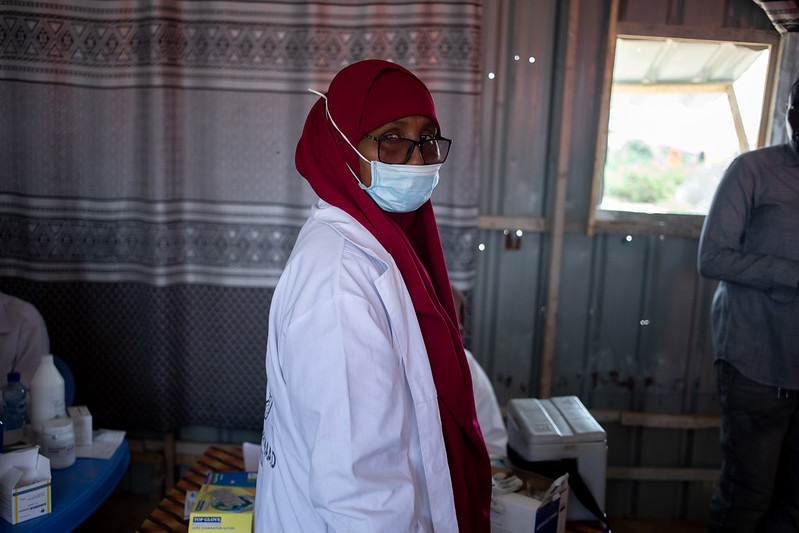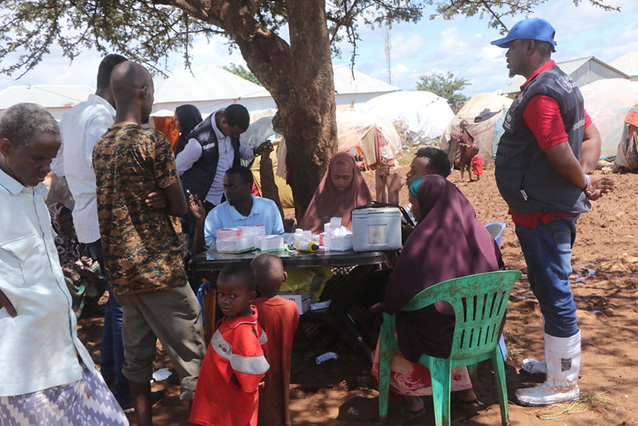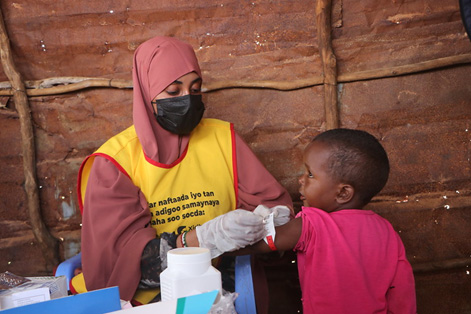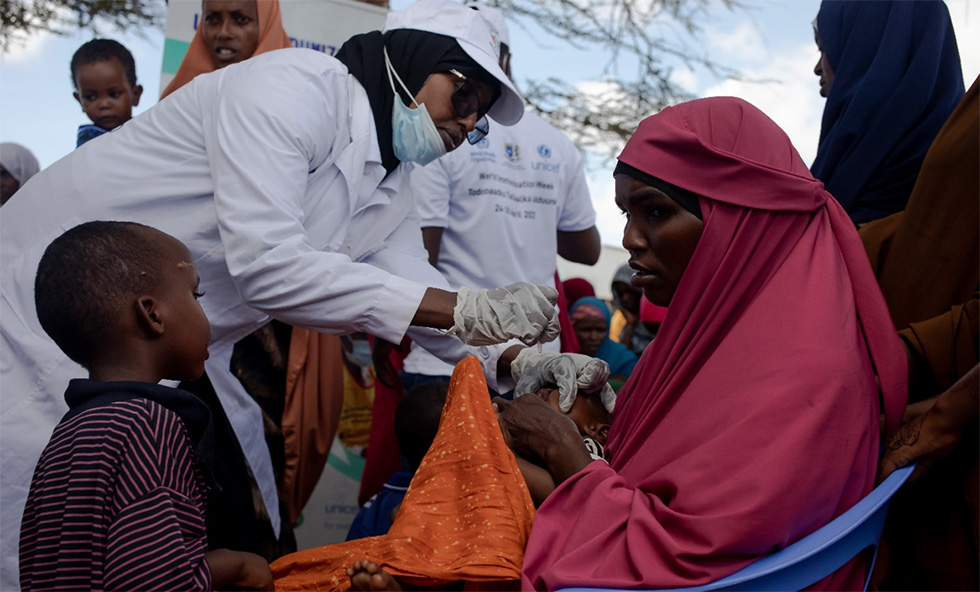International Women’s Day 2024: advancing gender equality in Somalia’s health workforce
 8 March 2024, Mogadishu, Somalia – Somalia’s health ministry and WHO observed International Women’s Day 2024 with a resolve to improve life for women in Somalia by empowering the female health workforce. To do so, they will address policy, human resource and operational matters, as well as capacity-building gaps for women in the health sector.
8 March 2024, Mogadishu, Somalia – Somalia’s health ministry and WHO observed International Women’s Day 2024 with a resolve to improve life for women in Somalia by empowering the female health workforce. To do so, they will address policy, human resource and operational matters, as well as capacity-building gaps for women in the health sector.
“Invest in women: Accelerate progress” is this year’s theme for the global day – and a timely reminder to world leaders to meet the targets of Sustainable Development Goal 3.
Dr Naima Abdulkadir, Manager of Reproductive Health at the Federal Ministry of Health and Human Services, thanked WHO for its support to various capacity-building efforts by the Ministry. She said she hoped: “WHO will continue to invest in trainings like mid-level management, integrated management of newborn and childhood illnesses, basic as well as emergency obstetric and newborn care, maternal and perinatal death surveillance and response and support for survivors of gender-based violence, because initial results of these trainings have been very encouraging and it will surely help in women’s empowerment in the health sector especially in newly liberated areas and in decision-making bodies.”
Life is harsh for many girls and women in the country. Somalia ranks fourth lowest among all countries globally for gender equality; its maternal and infant mortality rates are some of the highest in the world; and child marriage is widespread.
Women are often more affected than men by the recurring climatic shocks and ongoing conflicts that cause mass displacement across the country. More than 80% of the country’s 3.8 million internally displaced people are women and children. Many of them lack access to basic health services such as psychosocial support, reproductive health services, child and adolescent health services, and support for survivors of gender-based violence.
Somalia remains one of the most dangerous places to give birth. One in 1000 girls and women of reproductive age (15–49 years) die due to pregnancy or birth-related complications. Access to antenatal and postnatal care is still very limited: only 24% of women receive the WHO-recommended 4 or more antenatal care sessions during their pregnancy.
Despite recurring droughts, the COVID-19 pandemic and El Niño-related floods in Somalia, WHO and the Federal Ministry of Health and Human Services have made some progress in addressing women’s health issues under the wider umbrella of universal health coverage.
WHO Somalia supported the Ministry to revise (and cost the operational plan for) the National Reproductive, Maternal, Newborn, Child and Adolescent Health (RMNCAH) Strategy for 2023–2027. It also helped developing various guidelines for health worker capacity-building and for preparing women for health sector leadership roles.
The National Health Professionals Council, the regulatory framework for health professionals, is accelerating the process for registration of nurses and midwives, mostly women. In terms of patients’ right to health, the regulations and code of conduct are promoting the entitlement of women to decide about medical treatment, a critical step on a long way.
Dr Al-Umra Umar, Programme Lead for RMNCAH at WHO Somalia, welcomed the validation of the National RMNCAH Strategy, and added: “To tackle the high maternal and neonatal as well as under-five mortality, we urge the donor community to step up and help WHO streamline and reform the health sector by investing in an evidence-based and women-centred futuristic roadmap.”
“Slowly but gradually, we have managed to assemble an accountable and measurable framework to help address the predicaments of Somalia’s women, newborns and adolescents,” she said. “We will continue to build the capacities of women to help them take on decision-making and leadership roles.”
Media contacts
For more information, please contact:
Fouzia Bano, Communications Officer, WHO Somalia
Email:
Saeed Ahmed, Donor Reporting and External Relations Officer, WHO Somalia
Email:
Notes to editors
Somalia has some of the highest rates of neonatal and under-five mortality in the world, with an under-five mortality rate of 117 per 1000 live births. In addition, more than 1.5 million children aged under 5 years are currently at risk of severe malnutrition and related health complications due to the ongoing drought crisis. Somalia has a significant population of young people: over 45% of the population is aged under 15 years; about 75% of the population is aged under 30 years.
The latest Somali Health and Demographic Survey shows that female genital mutilation affects 99.2% of girls and women aged 15–49 years. This harmful practice has both short- and long-term physiological, sexual and psychological impacts. Gender-based violence is one of the most prevalent human rights violations faced by people, women especially, across the globe. Since the outbreak of COVID-19, women and girls have faced an even greater risk of such violence. Moreover, 35% of girls in Somalia go through child marriage, and there is no legal framework to stop it in courts.
Somalia’s gross domestic product per capita has consistently ranked among the 5 lowest in the world over the last decade; in 2020, it was the second lowest globally. In 2019, the International Labour Organization estimated labour force participation among those aged 15–64 years at 73.6% for men and just 23.1% for women. These figures have been relatively stable over the past 10 years. Agriculture still employs more men (79.2% of the labour force) and women (83.9%) than any other sector.
CERF support safeguards lives of 95.9% of children at WHO-Supported stabilization centres in Somalia
 WHO–CERF support helped Somalia’s Federal Ministry of Health to set up outreach camps for flood-affected communities across Jubaland and Hirshabelle states. Photo credit: WHO Somalia/A. Mustaf08 February 2024, Mogadishu, Somalia – The WHO Country Office in Somalia, with timely support from the Central Emergency Response Fund (CERF), has helped to avert major diseases outbreaks after flash flooding caused by El Niño. The floods, which hit the country in November 2023, damaged infrastructure and affected the livelihoods and health of over 1.17 million people across Jubaland and Hirshabelle states.
WHO–CERF support helped Somalia’s Federal Ministry of Health to set up outreach camps for flood-affected communities across Jubaland and Hirshabelle states. Photo credit: WHO Somalia/A. Mustaf08 February 2024, Mogadishu, Somalia – The WHO Country Office in Somalia, with timely support from the Central Emergency Response Fund (CERF), has helped to avert major diseases outbreaks after flash flooding caused by El Niño. The floods, which hit the country in November 2023, damaged infrastructure and affected the livelihoods and health of over 1.17 million people across Jubaland and Hirshabelle states.
“The floods have swept away everything we had, but thanks to WHO, my 2 children have survived not only droughts and floods but are now recovering from severe malnutrition at the Kismayo General Hospital,” said the worried but satisfied Rasuliyan, mother of Haniya (aged 3 years) and Uthman (aged 4 years) while visiting one of 64 WHO-supported stabilization centres in the country.
To mitigate the impact of El Niño and the Indian Ocean Dipole, WHO Somalia – with the support from CERF – supported the federal and state ministries of health to boost their efforts to meet the growing needs of over 500 000 displaced people. It did so by deploying over 25 outreach teams – comprising 100 health workers in total: nurses, clinicians, social workers and nutrition screeners – and 130 community health workers (CHWs).
By the end of January 2024, the outreach teams had managed to reach 163 880 people, including 4148 pregnant women, in the most affected districts across the 2 states. They held 93 416 outpatient consultations, administered 23 145 vaccinations and referred 5418 people with severe medical ailments to more specialized care.
The WHO–CERF initiative has helped to equip and staff the stabilization centres at Kismayo General Hospital, Baardheere District Hospital, Beledweyne Hospital and Jowhar Hospital to support the management of cases of acute malnutrition with complications. These cases may be referred by the CHWs and the outreach teams or may be admitted via another entry point.
 Outreach teams screened 33 767 children aged under 5 years, identifying 4833 children with severe acute malnutrition who were referred to outpatient therapeutic and stabilization centres. Photo credit: WHO Somalia/A. Mustaf“Of all the admissions in these stabilization centres, 95.9% were cured,” said WHO’s Incident Manager Dr Ifeanyi Okudo. He added that CHWs remain crucial as they administer micronutrient supplements within the displaced communities. By the end of January, they had reached 4148 pregnant women with iron and folic acid to prevent anaemia and birth defects. They also provided 4088 children with vitamin A supplements to boost immunity to diseases such as measles and pneumonia and to prevent blindness, which is common in malnourished children.
Outreach teams screened 33 767 children aged under 5 years, identifying 4833 children with severe acute malnutrition who were referred to outpatient therapeutic and stabilization centres. Photo credit: WHO Somalia/A. Mustaf“Of all the admissions in these stabilization centres, 95.9% were cured,” said WHO’s Incident Manager Dr Ifeanyi Okudo. He added that CHWs remain crucial as they administer micronutrient supplements within the displaced communities. By the end of January, they had reached 4148 pregnant women with iron and folic acid to prevent anaemia and birth defects. They also provided 4088 children with vitamin A supplements to boost immunity to diseases such as measles and pneumonia and to prevent blindness, which is common in malnourished children.
The 130 CHWs deployed in the affected communities also helped screen 33 767 children aged under 5 years for malnutrition using mid-upper arm circumference tape. This effort identified 4833 children with severe acute malnutrition, who were referred to outpatient therapeutic and stabilization centres for care.
The CERF support also helped WHO to procure 22 paediatric kits for children with severe acute malnutrition. These have been provided to the stabilization centres in the Kismayo General, Baardheere District, Beledweyne and Jowhar hospitals. The kits will be used to manage cases of acute malnutrition with complications referred to the centres by the CHWs and the outreach teams.
For more information, please contact:
Fouzia Bano, Communications Officer, WHO Somalia
Email:
Saeed Ahmed, Reporting/External Relations Officer, WHO Somalia
Email:
Related links
Every Breath Counts: increasing access to medical oxygen in Somalia
 Supervisor General of King Salman Humanitarian Aoid and Relief Centre (KSrelief) His Excellency Abdullah Al Rabeeh address to inaugural ceremony of project in Mogadishu on 28 January 2024. Photo Credit: courtesy KSrelief
Supervisor General of King Salman Humanitarian Aoid and Relief Centre (KSrelief) His Excellency Abdullah Al Rabeeh address to inaugural ceremony of project in Mogadishu on 28 January 2024. Photo Credit: courtesy KSrelief
29 January 2024, Mogadishu, Somalia – A project to reduce the alarmingly high number of child deaths related to pneumonia and diarrhoea in Somalia has been formally launched by King Salman Humanitarian Aid and Relief Centre (KSrelief) and WHO. The Every Breath Counts project aims to increase access to medical oxygen, set up mother and child health care, establish oral rehydration centres and provide integrated health facilities in the fragile humanitarian setting of Somalia.
Child mortality from all causes in Somalia is among the highest in the world. A child born in Somalia today is about 16.5 times more likely to die before the age of 5 years than a child elsewhere. Every Breath Counts aims to reduce pneumonia- and diarrhoea-related morbidity and mortality among children aged under 5 years in the project’s target districts.
Supervisor General of KSrelief His Excellency Abdullah Al Rabeeah launched the project along with Prime Minister of Somalia His Excellency Hamza Abdi Barre, WHO Representative in Somalia Dr Sindani Ireneaus Sebit and other high-ranking government and United Nations officials.
H.E. Mr Hamza Abdi Barre expressed profound thanks to the visiting dignitaries, to Saudi Arabia and to KSrelief for extending much-needed support to Somalia’s fragile health system: “KSrelief and WHO are helping to set up a sustainable health delivery model which will prove beneficial not only for achieving universal health coverage but also Somalia’s key elements of Essential Package of Health Services.”
The project is set to equip 28 health facilities across 10 select drought- and pneumonia-affected districts with solar-powered oxygen concentrators. The project will also provide 90 oxygen cylinders, 15 baby incubators and 4 ambulances in total to the selected health facilities. In addition, the project will help set up 15 triage centres and oral rehydration centres.
H.E. Dr Abdullah Al Rabeeah said on launching the project: “KSrelief is investing in the future of Somalia by providing self-sustainable and environment-friendly solutions and ensuring that selected health facilities can run various medical procedures especially for children and women without power interruptions.”
An estimated 230 127 children aged under 5 years and more than 3.3 million community members will benefit from the project interventions. Over 700 health workers will be trained on screening, outreach and treatment procedures in the course of the project.
Praising KSrelief for investing in saving the lives of Somalia’s children, acting Head of Mission for WHO Somalia country office, Dr Sindani Ireneaus Sebit said: “Contrary to what this situation in Somalia looks like, WHO has shown that community-based outreach programmes involving visits by community health workers to individual households for the diagnosis, treatment and care of pneumonia and diarrhoea and linking these interventions to primary-level care facilities can be a game-changer.”
Currently, the under-five mortality rate in Somalia is 117 per 1000 live births, which is higher than the sub-Saharan African average of 76 deaths per 1000 per live births. Approximately 21% of these deaths among children aged under 5 years in Somalia are attributed to pneumonia, while 18–20% of the deaths are attributed to diarrhoeal diseases alone.
Project interventions
The KSrelief resources will help WHO to set up cost-effective and evidence-based life-saving interventions in 10 districts of Somalia. The focus will be on strengthening community-based preventive, promotive and curative care and care for sick children with symptoms of child pneumonia and diarrhoeal disease.
The project activities will also help strengthen the capacities of primary health care/maternity and child health centres and district hospitals (referral hospitals) to deliver essential health services for pregnant women and people with disabilities. Across the 10 target districts, 28 health facilities will also be equipped to deliver both ambulatory and acute care for sick children diagnosed with pneumonia or diarrhoeal disease.
The services will be aligned within the overarching framework of the Government of Somalia’s vision for universal health coverage. This is consistent with the Government’s plan for implementing its Essential Package of Health Services (EPHS 2020) at the community and primary levels of care to achieve universal health coverage.
Notes to editors
 Somalia’s under-five mortality rate is 117 deaths per 1000 live births – one of the highest rates in the world. Photo credit: WHO Somalia/ I. TaxtaThe integrated Global Action Plan for the Prevention and Control of Pneumonia and Diarrhoea set a global target to reduce pneumonia-related deaths in children aged under 5 years to 3 deaths per 1000 live births. Currently, however, there are 39.5 child pneumonia deaths per 1000 live births in Somalia – which shows how far the country is from achieving the global target.
Somalia’s under-five mortality rate is 117 deaths per 1000 live births – one of the highest rates in the world. Photo credit: WHO Somalia/ I. TaxtaThe integrated Global Action Plan for the Prevention and Control of Pneumonia and Diarrhoea set a global target to reduce pneumonia-related deaths in children aged under 5 years to 3 deaths per 1000 live births. Currently, however, there are 39.5 child pneumonia deaths per 1000 live births in Somalia – which shows how far the country is from achieving the global target.
Somalia has a high burden and prevalence of risk factors for childhood pneumonia and diarrhoea, including non-exclusive breastfeeding, overcrowding in camps for internally displaced people, high rates of malnutrition and indoor air pollution, poor immunization coverage, and lack of access to quality health care for sick children at the community level. These factors will continue to contribute to a high number of deaths from these preventable causes if the situation cannot be improved.
The current humanitarian situation in Somalia – which results from protracted conflict, civil war, climatic shock and mass displacement – also contributes to poor health service delivery across the country. This has resulted in poor access to health care for vulnerable groups such as disadvantaged children.
Over 7.8 million people in Somalia are adversely affected by climatic shock – of whom more than 1.1 million have been displaced. The Government has declared the current drought situation an “acute humanitarian emergency” and appealed for emergency assistance from international partners and humanitarian agencies.
The drought situation may further aggravate the health conditions of children aged under 5 years because of children’s worsening nutrition condition and the lack of health services in affected areas. This may lead to excess morbidity and mortality from high-burden diseases such as pneumonia and diarrhoeal diseases.
For additional information, please contact:
Fouzia Bano, Communications Officer, WHO Somalia
Email:
Saeed Ahmed, External Relations /Reporting Officer, WHO Somalia
Email:
For more details about WHO’s response across Somalia, see:
WHO and KSrelief helps trains 28 health professionals on basic emergency care
Somalia launches electronic immunization registry in latest leap of innovation
 With the launch of an electronic immunization registry in Somalia, WHO Somalia and the Federal Ministry of Health plan to improve the country’s immunization profile. Photo credit: WHO Somalia/I. Taxta
With the launch of an electronic immunization registry in Somalia, WHO Somalia and the Federal Ministry of Health plan to improve the country’s immunization profile. Photo credit: WHO Somalia/I. Taxta
16 January 2024, Mogadishu, Somalia – An electronic immunization registry is set to help increase and streamline immunization coverage in Somalia, with a special focus on children who are new to immunization, defaulters, zero-dose status or underimmunized. WHO Somalia, in collaboration with the United States Agency for International Development, has supported the Federal Ministry of Health to develop and launch the digital platform.
The immunization registry consists of tools that can be used to help monitor individual immunization schedules and store individual immunization histories. As such, using the platform and its tools can help enhance the performance of the Expanded Programme on Immunization (EPI), in terms of both coverage and efficiency.
Somalia is currently managing to reach 720 000 children aged under 1 year through its routine immunization programme. Another 3.6 million children aged under 5 years are reached through special campaigns in hard-to-reach areas or via mobile teams able to help people on the move catch up with missed vaccinations.
Somalia has thus far been using paper-based registration at the individual immunization centres at primary health units, with the data then sent to DHIS2, the open-source digital database. Paper-based data and vaccination cards cannot be used, however, to track and trace children who are missed or overlooked, or whose caregivers fail to bring them for routine vaccination due to financial hardship or any number of other reasons.
“This registry will help develop individual data for each child, with a unique ID, and will be available on the system all across the country. No matter where the family has moved, they can still go to any nearby immunization centre and get their child the required vaccine, without getting a duplicate registry or missing out the previous record of immunization administered to child anywhere in the country,” explained Dr Muhammad Farid, the focal person for WHO Somalia’s Expanded prorgamme on immunization (EPI) programme.
WHO Somalia helped to develop the electronic immunization registry at the request of the Federal Ministry of Health. The country office was able to pursue this latest leap of innovation with the support of its globally recognized partner, the HISP Centre at the University of Oslo, which manages the DHIS2 project.
Previously, from August 2020 to August 2021, WHO Somalia and the HISP Centre had supported the Ministry to review and revise all data elements, indicators and data collection tools for DHIS2. This exercise helped to update Somalia’s DHIS2 platform by adding new indicators, data elements and forms on a government-owned server.
The revised DHIS2 platform has now, finally, helped to unify data relating to EPI; nutrition; the Integrated Diseases Surveillance and Response System; and HIV, tuberculosis and other health conditions.
“We are delighted that after helping us to update the DHIS2 platform, WHO has helped us to conduct training of trainers and, eventually, cascade these trainings to help the Ministry of Health, state, regional and district data officers get hands-on training sessions on the new data collection tools, data entry on the new platform, and get familiarized with the new features such as maps, data visualization and data validation rules,” observed Mohammad Abdullahi, the Federal Ministry of Health focal point for Somalia’s Health Management Information System.
For more information, please contact:
Fouzia Bano, Communications Officer, WHO Somalia
Email:
Saeed Ahmed, Reporting/External Relations Officer, WHO Somalia
Email:
Notes to editors:
For more details about WHO’s response across Somalia, see:
USAID support leads to 47% of eligible Somalis being vaccinated against COVID-19


